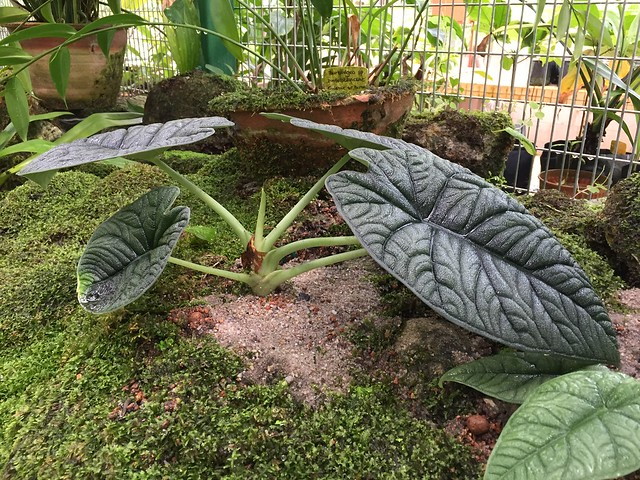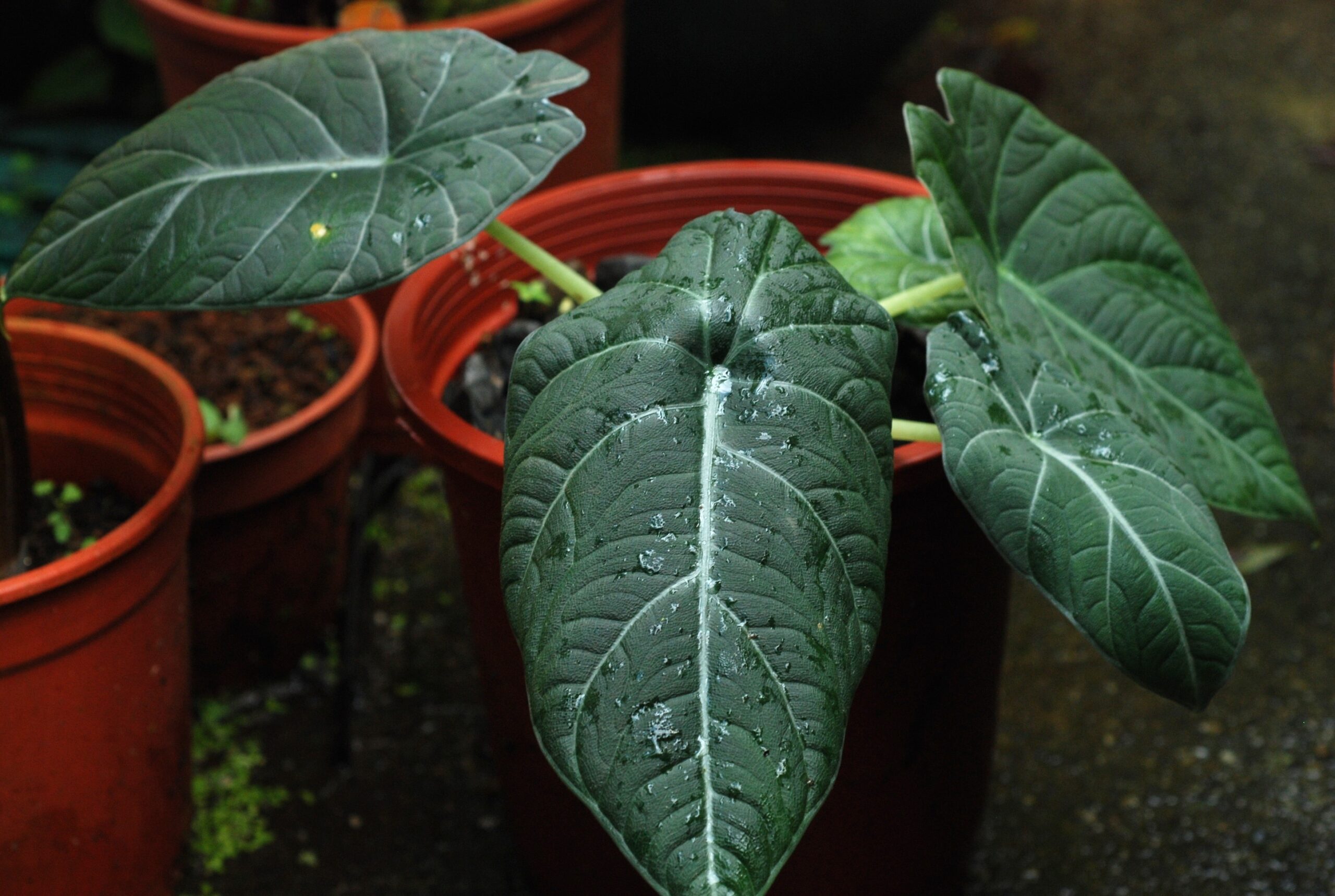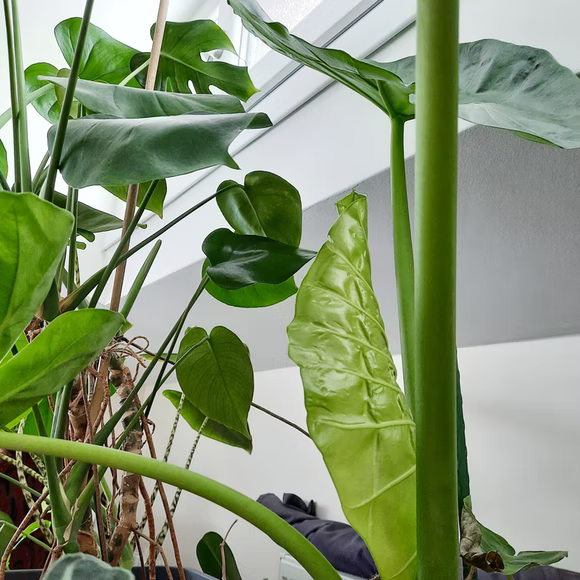With its premium look and compact size, Alocasia’ Maharani‘ is one to have in your plant collection. This tropical plant, called African Mask, Kris Plant, Grey Dragon, or Elephant Ears, is undoubtedly a gem for your growing plant situation. It is not called the Jewel Alocasia for anything less.

Thinking of owning and growing this exotic beauty? Learn more about this plant here.
Alocasia Maharani Profile
General Information
Alocasia ‘Maharani’, commonly called Grey Dragon, is a rare, dwarf hybrid of Alocasia reginula and Alocasia melo (Alocasia Rugosa). This mini tropical hybrid originates from South East Asia and only grows up to 1-2 feet maximum. Maharani is a great indoor houseplant and a crowd favorite.
The winning feature of this Alocasia is the appearance of its unique foliage. The foliage is grayish-green with a silvery hue and a reddish underside. The leathery, thick leaves make them look like plastic. The reptilian-like veining and rough texture also add to the premium feel of the plant.
Etymology
The petite hybrid’s name, Maharani, directly means female royalty, either a queen or a princess in India. The name could be due to its rarity originating from South East Asia.
Flowering
Maharani has a distinct flower type or ‘inflorescence’ called a spadix. The inflorescence has two main parts called the spadix, a stem containing the clusters of small off-white flowers, and a spathe, a leaf-like green structure surrounding the spadix. The plant generally blooms in early spring; however, it cannot be relied upon as it rarely flowers.
Season Of Interest And Purchasing
Maharani’s growing season is all-year-round as a herbaceous perennial. Therefore, it is one of the most sought-after jewel Alocasias. This Alocasia is an excellent decorative statement at home and in gardens.
Growth
Maharani is a slow-growing hybrid. It takes almost two to three years to reach its maturity, with proper nourishment and care. When grown as indoor plants, the growth rate of this alocasia increases.
Alocasia ‘Maharani’ Overview
| Scientific name | Alocasia ‘Maharani’ |
| Common name/s | Grey Dragon |
| Family | Araceae |
| Growth Habit | Herbaceous |
| Height and Spread | Depends on the space. If in soil, 24-36 inches. If in pots, 8-14 inches. Shorter in terrariums and vivariums. |
| Classification based on life cycle | Perennial |
| Origin and Distribution | Native in South East Asia. Commercially available around the world. |
| Climate Zone | Generally warmer climate |
| USDA Plant Hardiness Zone | USDA Zone 10 – 11 |
| Color | Distinct gray-green shade |
RELATED: 11 Outdoor Foliage Plants To Arrange Your Garden Like A Professional Landscape Designer
Care Tips

Light Requirement
Medium to bright indirect light is required for this plant to grow steadily. A maximum of six hours of light will ensure the plant stays green and fresh. Direct sun, however, will burn its leaves.
When growing this Alocasia indoors, it is best to put it beside a well-lit window away from direct sunlight. It must also be repositioned and rotated as much as possible to receive an equal amount of light exposure. It is also best to let it out once or twice a week for heaps of sunlight.
Temperature Requirement
Almost all Alocasia species need an intermediate-warm temperature to thrive. The ideal temperature range of 12-27 degrees Celsius will make Maharani happy. However, a comfortable room temperature is more than enough for this plant.
Maharani has a low tolerance for cold temperatures. Therefore, during the winter season or when the temperature falls below 12 degrees Celsius, it is best to transfer this plant indoors to a warm spot.
Water Requirement
The rare monocot plant has the exact water requirement as the rest of the Aroids. They prefer thorough watering to ensure the soil is moist. Tap water can be used to water Alocasia Maharani. Once a week of watering on regular days is enough for this Alocasia. The soil must be completely dry between waterings to avoid root rot.
However, seasonal changes also change the frequency of watering. Frequent watering is recommended 2-3 times a week during high-temperature seasons like summer. On the other hand, watering must be cut down in winters, especially when the plant is dormant.
Humidity Requirement
The dwarf hybrid needs a high moisture level to keep its artificial-like leaves fresh. The ideal humidity for this alocasia hybrid is 80%. Many ways can be done to achieve this high humidity, such as the pebble tray method or misting. Collective humidity by grouping indoor plants together can also help this Alocasia thrive.
Soil Requirement
A moist, well-draining soil that is slightly acidic, with ph 5.5 – 6.5, is essential for a healthy Alocasia maharani ‘Grey Dragon’. Conversely, compact, excess soil that is easily waterlogged is a no-no for Maharanis.
Fertilizer Requirement
Grey Dragon, a heavy feeder, needs proper fertilization for optimum growth. A regular fertilizer can work wonders. Liquid fertilizers can be used as long as it is diluted to half their strength before putting to the soil, or else they will burn roots.
Once-month fertilization is recommended, except in winters when it can do more harm than good. A high nitrogen content fertilizer is best for alocasia foliage growth.
Space Requirement
The Alocasia Maharani plant does not need ample space to grow. Instead, a minimal space requirement is necessary. Although it can be grown directly in the soil or pots, it is best for decorative containers such as terrariums or vivariums.
Growing And Planting Tips
Propagation
Alocasia Maharani propagation can be done via three methods. These are (1) by division, (2) by seeds, and (3) by water. It is best to propagate no matter the chosen method in early spring until late summer.
1. Propagation by Division
Like any other Alocasia, Alocasia Maharani grows and multiplies through the formation of “clumps” or “pups”. The mother plant produces these pups. Gently separate the pups from mature plants via a sharp blade or a knife and plant them in a separate new pot with an appropriate growing medium. A healthy alocasia will grow in soil in just 3-4 weeks.
2. Propagation by Water
The easiest method to propagate Maharani is via water propagation. The pups taken from a parent plant can be submerged in distilled water to take roots. Water must be changed every week to avoid contamination. Once an excellent rooting system develops, they can be transferred to a proper growing medium.
3. Propagation by Seeds
Out of all the methods, propagation by seeds is the least popular since it is time-consuming and Maharani rarely bears fruits. If you are lucky to have fruits, remove the seed and deep soak it using a damp cloth before planting in a proper soil medium. At least 3-4 weeks is enough for an alocasia to grow from seeds.
Pruning
There is no regular pruning needed for this rare indoor plant. Removing the damaged leaves of this slow-grower is enough for it to look healthy and radiant. The bottom damaged leaves must be removed first and then upwards to make room for new leaves and encourage more branching.
Potting And Repotting
Maharani does not need repotting now and then. This Alocasia needs repotting only when the roots are pot-bound and completely grow throughout the soil. One significant indication of the perfect time to re-pot is when roots peek out of the drainage holes in the pot. When repotting, the soil medium must also be renewed.
Use of perlite and coir fibers is recommended for Maharani. These ingredients increase aeration in soil and provide good drainage. Regular potting mix can also be used for actively growing plants.
Alocasia Maharani Care
| Light | Medium to indirect bright light |
| Temperature | Intermediate to warm, 12-27 degrees Celsius |
| Water | Once a week, increased in summer, decreased in winter |
| Soil | Well-draining, moist soil |
| Fertilization | Regular household fertilizer, once a month |
| Space | Minimal space |
| Propagation | Via division, water, or seeds |
| Blooming | Rarely blooms, enough sunlight and maturity needed |
| Pruning | Not regular, removal of damaged leaves recommended |
| Potting | Regular potting mix, use of perlite and coir fibers recommended |
Problems And Troubleshooting
Overwatering
A general drooping of leaves will tell you that your tropical plants are overwatered. Wet feet and yellowing, watery blisters, edema, and brown spots can also be seen on the leaf surfaces. The result of overwatering, root rotting, is characterized by the smell of rotting tissue, especially on the base of the plant.
To fix this, make sure to water your Alocasia correctly and that the minimum requirements such as well-draining moist soil, bright indirect light, and moisture level are met. Also, avoid planting this small Alocasia in a large pot to decrease the chance of overwatering. When repotting, go for a pot with drainage holes not larger than the plant by 1-2 inches.
Underwatering
Underwatered Alocasia plants are easier to look out for. The presence of brown, crispy alocasia maharani leaves, edges, or tips results from water lacking. A cracky, upper soil is also a great sign that a plant is underwatered.
To fix this, examine the possible factors that could contribute to underwatering. Often, this is only due to the lack of attention to the plant’s needs.
However, it can also be a sign of having pot-bound roots. You can re-pot it to a bigger pot and ensure that Maharani is put in the ideal growing zone.
Nutrient Deficiency
The common nutrient deficiency symptoms in plants can also be observed in Alocasia Maharani. These symptoms include yellowing leaf surface or edges, holes, burnt leaves, purplish hues on leaves, brown spots, distorted leaves, soft texture, and stunted roots.
Make sure that the right and balanced fertilizer is in use to fix this. Nutrient strength must also be since a strength that is too strong is detrimental to plants and could lead to slower or stunted growth. Soil pH must also be in the optimum range to improve nutrient uptake of Maharani.
Flowering Problems
Like any other Alocasias, Maharani does not have a regular flowering season. Therefore, the flowering time of these plants cannot be relied on.
But to ensure that your Maharani will produce flowers, make sure that the optimum care and requirements are given. Light sufficiency is also crucial for successful flowering.
RELATED: Prayer Plant’s Bloom 101 | How To Make Your Prayer Plant Bloom Fast!
Pests And Diseases
Alocasia Maharani Pests And Diseases
| Common Pests/Diseases | Symptoms | Treatment and Prevention |
Common diseases include crown rot, stem rot, root rot, leaf spot, fungal diseases, and Xanthomonas infection | Yellowish rimming around black or dark brown spots on leaves | Avoid overwatering. Keep soil dry. Avoid too high humidity.Proper ventilation is needed around the plant. Remove infected parts of fungal infections to avoid spreading. |
| Common pests include mealybugs, spider mites, aphids, and scales | Visible insects on the surface | Spray plant with warm, soapy water. If infestation is present, use insecticide or neem oil. |
Problems With People And Animals
Toxicity
Although beautiful and rare, both the foliage and the stem of Maharani contain calcium oxalate crystals, which are toxic to both animals and humans. They can induce irritation and swell in the throat and mouth. In worst situations, they can even cause death.
Alocasia Plants Meaning And Symbolism
Alocasias are akin to Jack and the Beanstalk fairytale in Western and Eastern versions. They say that the “tree that grows up to the heavens” is an alocasia, even though botanically speaking, it is not a tree.

With this attribute, alocasias symbolize seizing opportunities and taking risks. They are great gifts for someone about to take a step forward in their lives, may it be opening a new business, going off to college, or venturing to a new city.
Alocasia Maharani Symbolism and Meaning
| General Meaning | “plant that grows up to heavens” |
| Symbolism | seizing opportunities and taking risks |
| Cultural Significance | attributed with Jack and the Beanstalk fairytale |
Landscaping And Gardening Ideas
Companion Plants
Plants with foliage shaped as elephant ear, such as Maharani, exudes lush, tropical scenery vibes, which can add a unique flair to gardens and indoor spaces. A great variety of Caladiums, Colocasia, Xanthosoma, and other Alocasias such as Black Velvet and African Mask, are great companion plants of Maharani.
For a more tropical feel, Canna lilies, Decorative Bananas, Dieffenbachia, Ficus, Schefflera, and Coleus can also be along with Maharani.
Landscaping Ideas
The petite Alocasia can be on to the perennial border in the gardens to serve as a focal point. Its distinctive leaves, shaped like elephant ears, are a good break from the rest of the plants, especially those with colorful hues.
In containers such as terrariums and vivariums, it can be an exotic centerpiece when mixed with other foliage and flowering plants. Purple-hued plants also provide more drama when combined with the textured leaves of Maharani.
| What to plant with | Caladiums, Colocasias, Alocasias, Xanthosomas, Canna Lilies, Ornamental Bananas, Coleus, Dieffenbachia, Ficus, Schefflera |
| What NOT to plant with | Basically nothing |
Conclusion
Alocasia’ Maharani’ or ‘Grey Dragon’ is an excellent addition to any home or garden. Being a low-maintenance species, it is an easy-to-grow plant that is durable and can tolerate the environment at home. In addition, the Maharani plant is perfect for pots or terrariums, which could become a decorative statement in your office spaces, homes, and gardens.
FAQs
Why is my Maharani plant dying?
The critical care for the plant must be met. Thus, if it’s indoors, it could be that the humidity is too low as it needs high humidity and bright indirect sunlight. Pests such as spider mites may also be present.
Is Maharani a rare plant?
Yes, the Grey Dragon is a rare hybrid plant people usually plants indoors. However, this unusual aroid was born with different names because of its size and decorative leaves.
Can Maharani grow big?
Maharani is a small hybrid and can grow only up to a foot or two in height.
Is Alocasia Maharani care easy and suitable for beginners?
Definitely, yes. Maharani is an easy-growing plant.
Hope you like this Alocasia Maharani article. Make sure to check out our other articles:
11 Outdoor Foliage Plants To Arrange Your Garden Like A Professional Landscape Designer
Philodendron Warscewiczii: The #1 Complete Care, Watering, and Propagation Guide
Philodendron Paraiso Verde: Care, Watering, and Propagation Guide







